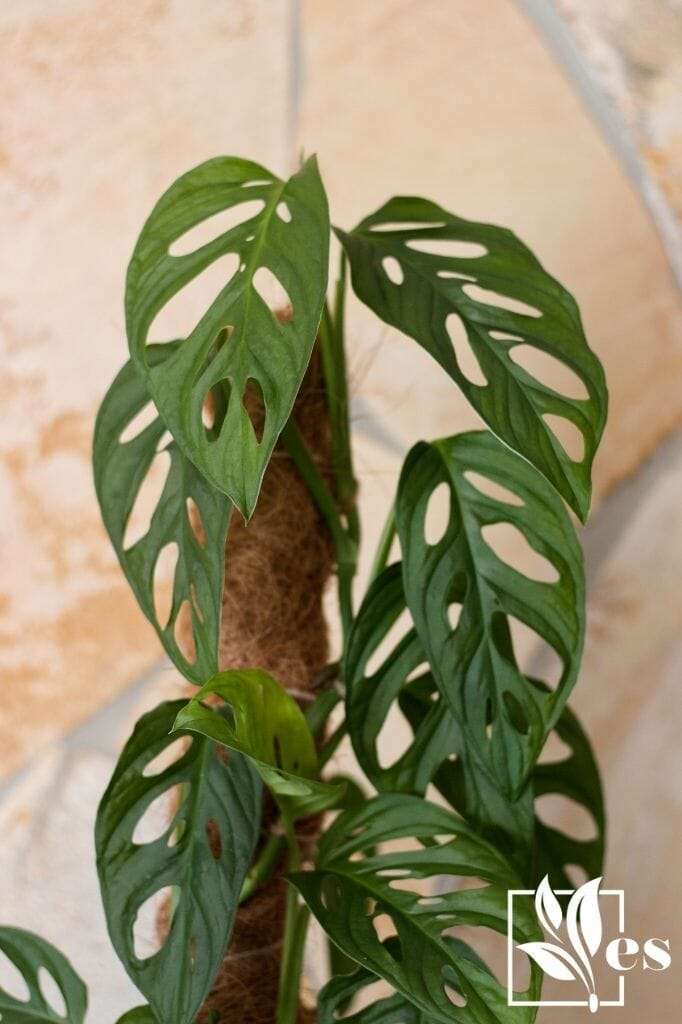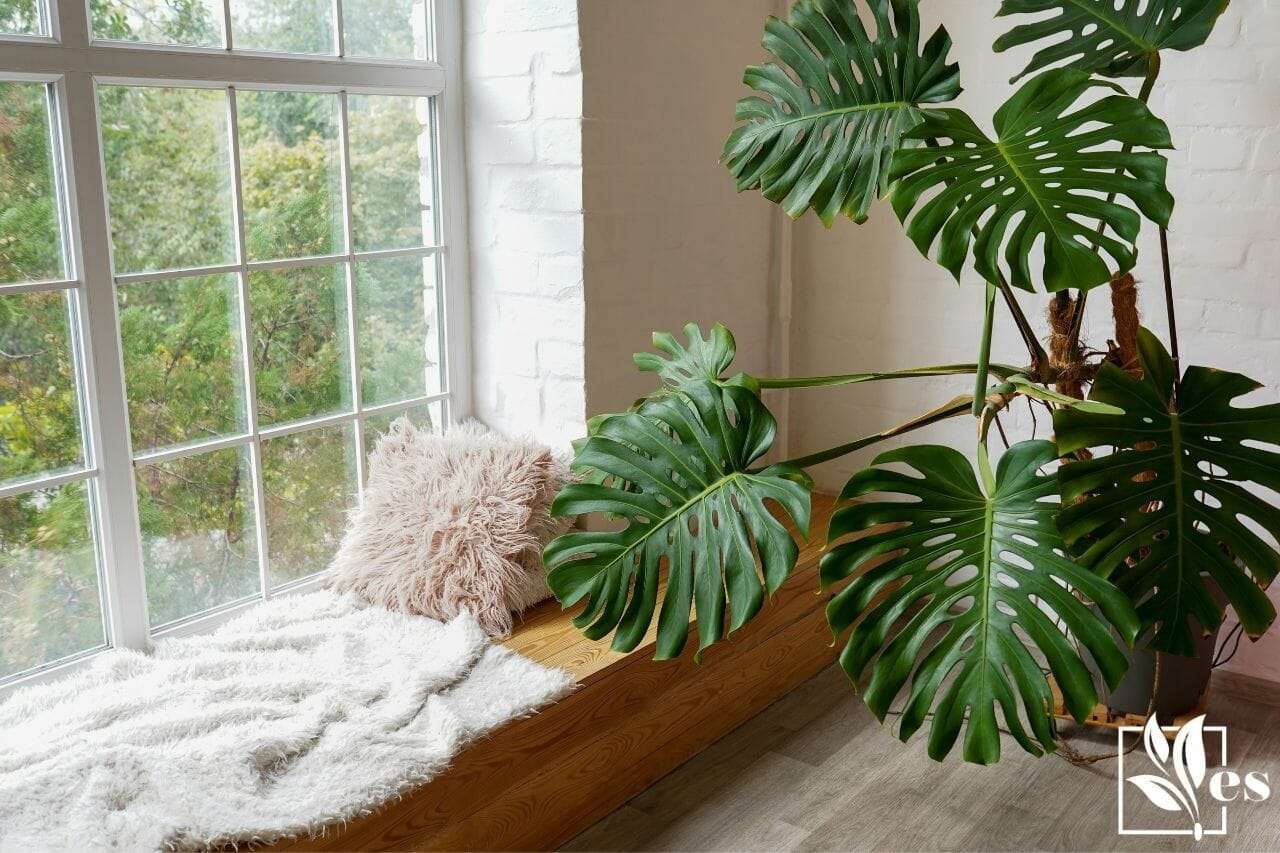 Rust fungus on monstera often looks worse than it actually is. You can get rid of it and make your plant healthy again in no time at all. Want to find out how?
Rust fungus on monstera often looks worse than it actually is. You can get rid of it and make your plant healthy again in no time at all. Want to find out how?
Read our all-encompassing guide to learn some easy ways to treat rust fungus on houseplants.
JUMP TO TOPIC
What Causes Rust Fungus on Monstera?
⚡️Some causes of rust fungus on monstera include overwatering, over-humidifying, and not providing enough circulation and light. Rust refers to a group of fungal diseases that often attack the monstera houseplant. The parts most commonly affected are the leaves, but the disease can also spread to stems, flowers, and fruits.
They are usually not very fatal diseases, but they do make your plant look unsightly. The same issue may appear on both Monstera Laniata and Lechleriana varieties. Read on to find out the major causes of rust fungus in detail.
– Too Much Warmth and Humidity
All fungi thrive under conditions that are consistently warm and moist. It is true that the humidity requirements of Monstera are more than 50 percent and it needs 70 to 80 degrees Fahrenheit temperature at all times for proper growth.
However, if you are overwatering your plant or misting it too much, then these same conditions will lead to the development of this disease.
– Poor Air Circulation
Air circulation is very important for all plants. Leaves that don’t receive adequate light and air are most commonly affected by fungal rust, plant diseases, and pest infestation. That is why pruning your plants is very important. It opens up spaces to let air in and around all parts of the plant.
It is also important not to place your plants in cramped corners. Don’t place two or more plants very close together either.
– Poor Light
This plant needs bright and indirect light for the majority of the day. This light is important not only for photosynthesis but also for the evaporation of excessive water. In conditions of low light, water droplets on the leaves fail to evaporate. This creates the perfect environment for the growth of bacteria.
– Transfer of Infection From Another Plant
This is another very common method by which your plant might get affected. Rust spores have the ability to float in the air and move from one plant to another. That is why you should isolate the affected plant as soon as it starts showing symptoms.
– Overwatering
Overwatering the plant will cause its soil to stay excessively wet all the time. Such soil serves as the ideal environment for the growth and rapid multiplication of the various fungal species that are responsible for causing rust. It also leads to more severe problems such as the development of the rapidly destructive root rot. Monstera leaves might also start turning black but it is a solvable problem.
Make sure that your soil is dry at the top 3 to 4 inches from its surface. Only then should you water it again. When watering, see that the drainage of the soil and the pot is not blocked or compromised in any way. The excess water should flow out of the drainage hole at the bottom.
– Transferred Through Infected Tools
Many a time you might have used gardening tools on multiple plants without cleaning them between each plant. This is a dangerous habit and one of the leading causes behind the transfer of infection from one plant to the next.
Properly cleaning and disinfecting instruments before use will go a long way to prevent rust fungus. Make sure that you wash your instruments with bactericidal and fungicidal soap and water each time.
Also, use a good quality disinfectant solution afterward. Alternatively, rubbing alcohol also works just as effectively. We always use 70 percent isopropyl alcohol for our gardening tools.
– Misting Late in the Day
Misting your plants is sometimes necessary in order to provide it with the required humidity levels. However, improper misting will lead your plant towards rust and other fungal conditions like powdery mildew and leaf spot disease.
Always mist before midday. This will allow the water droplets adequate time to evaporate properly before nighttime. Misting late in the evening leads to the droplets remaining on the plant all night. This, of course, leads to fungi making a home in your plant and infecting it.
Also, make sure to only lightly mist the plant each time. Some people bathe their plants in lieu of misting, which then proves disastrous in the long term.
Treatment
Treating brown spots with rust fungus is easy. You will first need to isolate the plant, then you can go for home-based remedies like sodium bicarbonate, vinegar, aspirin and neem oil, etc.
Alternatively, you can try commercial fungicides, but do make sure to improve the plant’s cultural conditions first. None of these treatment options will work unless you make sure that your plant’s conditions are not conducive to fungal infections.
Learn how to treat fungus on monstera in great detail in the coming section.
– Isolate the Affected Plant
The fungal spores that cause rust transfer very easily and quickly from one plant to another similar one. That is why it is very important to isolate the diseased plant. Otherwise, you will soon find the rest of your plants being affected by rust as well.
Ideally, you should move the diseased plant to a different room altogether. If that is not possible, then make sure it is a respectable distance from the rest of your collection.
Take great care that any gardening tool or instrument that comes in contact with a plant with brown spots is properly disinfected and cleaned. Only then should you use these tools on another plant.
– Prune the Affected Leaves and Plant Parts
Start treatment of the affected plant with rust spots by cutting off the infected leaves first. You can either chop off the entire leaf or just the part that is most seriously affected. If a majority of your plant is diseased, then it is better to cut the most severe parts only or your plant might have a hard time surviving.
You cannot use the pruned leaves and plant parts for anything else — this includes composting or mulching. Otherwise, you risk spreading rust to your entire pile of compost. It is better to just burn these debrided plant parts off.
Always use sharp gardening scissors or knives for pruning. This will make your work so much easier. Don’t forget to disinfect them thoroughly after use. We recommend using 70 percent isopropyl alcohol for disinfection.
– Use Baking Soda
Sodium bicarbonate is a common household kitchen ingredient that you can use to treat rust. It is quite a potent fungicide and will surely get rid of the fungal leaf spots from your rust-affected plant with consistent use.
– Different Types of Soda Foliar Sprays
You can make several different types of baking kitchen soda mixtures, then apply them as foliar sprays on the affected leaves.
Mix one teaspoon of soda in one-quarter of a gallon of water. Also, add some common dishwashing soap to it. Pour this mixture in a spray bottle. You can now use this mixture for months on end.
Alternatively, you can mix four teaspoons of soda with one ounce of horticultural oil and one gallon of water. Both these solutions have proven to be quite effective.
– How Often To Use Foliar Sprays
Spray the above-mentioned mixtures on your diseased plant on a weekly basis. It is better to spray lightly but make sure that no part remains unmedicated. Adding a bit of white vinegar to this mixture will also help.
You will need to spray your plant with this spray for at least three to four months. Only then will it start to show any progress. Dedication is the key here!
Remember that sodium bicarbonate is quite basic in nature. This product has a tendency to cause chemical burns to the plant if you are careless with it. Only use these foliar sprays once a week and in moderate amounts.
– Use Chamomile Tea
Chamomile is another natural antifungal agent. You can easily use it if you don’t want to expose your plant to harsh chemicals like sodium bicarbonate. It is also available in most kitchens and if not, you can simply purchase it from your local grocery store.
Simply boil some chamomile in water. Allow the tea to cool until it reaches room temperature, then put it in a spray bottle. Lightly douse your plant with this tea daily, and you should begin to see a marked improvement in symptoms soon enough.
Like all-natural remedies, chamomile tea will also take several weeks before you see any improvement. Often, leaves turn yellow due to fungal rust and take months before they regain their color back.
– Apply White Vinegar
White vinegar can also be a great help against this problem. All you have to do is to mix one part vinegar with one part water. Apply it to the diseased Monstera deliciosa plant every second or third day.
Keep in mind that we are talking about common household vinegar here. This one contains about 20 percent acetic acid and even this one needs to be diluted so that it is safe enough for the plant.
You can also opt for store-bought vinegar that has higher concentrations of acetic acid in it. These are obviously going to be more potent, but they will also need to be diluted more.
– Spray With Aspirin
Rust disease is another type of headache that Aspirin is a fantastic cure for. You can just use over-the-counter aspirin for these brown spots. The aspirin tablets preferably should be uncoated to produce the maximum effect.
Now, how can you use aspirin properly? Dissolve two to four tablets of aspirin in one gallon of water. Fill a spray bottle with this fungicidal mixture and spray every other day until you begin to see some improvement.
Aspirin can also be dissolved in water and applied directly to the affected monstera leaves. However, we do not recommend this method. Aspirin burn is a common phenomenon, and trust us, you do not want to subject your plant to it.
– Use Neem Oil
Neem oil for rust fungus is a time-tested household item that is a very strong antifungal agent. It is a completely natural ingredient that gets rid of rust without harming your plant. It is a multi-purpose plant saver, solving all sorts of problems ranging from fungal infections and spider mites infestations to plant leaves turning yellow.
Cotine reaading to find out the various ways you can use neem oil.
- First of all, decide on the type of neem you want to use. You can either buy pure neem oil or use a store-bought mixture containing some quantities of neem oil in it. We recommend buying pure neem oil to go the all-natural route.
- Take a Q-tip and wet it with one or two drops of neem oil. Apply this Q-tip directly on the spots on the leaves once a week. One major disadvantage of this method is that it is very time-consuming and needs a lot of effort.
- Alternatively, you can also make a DIY foliar spray using neem oil. Just take one liter of water and add one teaspoon of neem oil and half a teaspoon of dishwashing soap to it. This solution is now ready for use.
- Spray this mixture on the affected plant on a weekly basis until symptoms resolve. Afterward, you can decrease the frequency of spraying to only once fortnightly. This way, neem oil can also be used as a preventative measure against rust.
– Purchase Commercial Fungicides
Commercial fungicides are very effective when it comes to rust fungus treatment. There are a lot of these available in the market. You can buy and use any one of them, just make sure that you are following the instructions given on the back of the label to the tee.
Make sure that the fungicide you use has four important active ingredients present. These four ingredients are chlorothalonil, mancozeb, myclobutanil and trifloxystrobin. Carry on reading to learn two of the best commercial fungicides in use these days.
– Liquid Copper Fungicide
This is of the most widely used fungicides and bactericides in the plant world today. They get rid of not only rust, but also a large majority of fungal and bacterial diseases.
- Copper is a most useful substance when it comes to killing fungi. However, in large quantities, it also begins to kill plant cells.
- Always buy this fungicide from a trusted manufacturer and strictly follow the instructions on the label.
- Make sure to spray it every week without fail, or at least once every ten days at the very least. Spray no sooner than 7 days.
- Spray adequately both under and over the leaves. You want it to reach all the fungal spores and kill them.
- Make sure you are wearing protective clothing when spraying this on the plants. Wear eye goggles as well as tough leather gloves. Your clothes need to be full-sleeved and made of a thicker material.
– Sulfur Plant Fungicide
Sulfur-based fungicides are best for those who are invested in organic gardening. They are great for treating rust on monstera plants.
- This is another type of commercial fungicide that is pretty effective. The sulfur in its composition prevents the growth of fungal spores.
- Sulfur-based fungicides come in two forms. One form is simple powder. Take the dry powder and then sprinkle it all over the infected plants. Don’t leave anything out, especially the undersides of the leaves.
- It also comes in a powder form that is meant to be mixed with water. This is then sprayed on the plant according to the manufacturer’s instructions.
- Sulfur fungicides are relatively safer. They are non-toxic to both plants and humans. We can also say that it is the best fungicide for rust fungus.
- Take note that they are toxic to aquatic life, so take care not to pollute any bodies of water with them.
– Choose Rust-resistant Varieties of Plants
Plant hybridizers are constantly creating new varieties of plants that are resistant to common diseases. The same goes for monstera varieties. If you are sick and tired of having to deal with and treat this disease year after year, then maybe it’s time to get rid of your rust-susceptible monstera.
Contact a monstera expert near you and ask them to give you a cultivar that has been modified to resist this disease.
Still, you must keep in mind that even with resistant varieties, you must not neglect the basic requirements of fungus prevention. Make sure your plant has adequate drainage and air circulation.
– Improve Cultural Care
Before you learn how to treat rust fungus on plants, you must improve the plant’s cultural conditions. Otherwise, all your efforts will go to waste. All fungi thrive under dark, moist, and humid conditions.

Keep your precious monsteras in a room that is lit brightly with plenty of light received indirectly. Make sure this room is also well-ventilated. Pruning the plants regularly also helps in improving the circulation of air around all parts of the plant.
Water only when the top one to two inches of the soil dries up. Even then, make sure that extra water drains out without any impediment. Maintain high humidity but don’t mist the plant late in the day.












